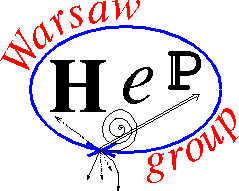SEMINARIUM FIZYKI WIELKICH ENERGII
Dnia 30 kwietnia (piątek) o godzinie 10:15, odbędzie się seminarium pt.:
Warsaw contributions to the 2021 International Workshop on Future Linear Colliders, LCWS2021 (part 2)
Referują:
Krzysztof Mękała: „Heavy Neutrinos at Future Linear e+e- Colliders”
With the Standard Model being unable to describe the observed baryon asymmetry or dark matter density in the universe, many models of the New Physics introduce heavy neutrino species as a possible explanation for these effects. Dirac or Majorana neutrinos with masses above the EW scale could be produced at future linear e+e- colliders, like the Compact LInear Collider (CLIC) or the International Linear Collider (ILC).
We studied the possibility of observing production and decays of heavy neutrinos in qql final state at the ILC running at 500 GeV and 1 TeV, and the CLIC running at 3 TeV. The analysis is based on the WHIZARD event generation and fast simulation of the detector response with DELPHES. Dirac and Majorana neutrinos with masses from 200 GeV to 3.2 TeV are considered. Estimated limits on the production cross sections and on the neutrino-lepton coupling are compared with the current limits coming from the LHC running at 13 TeV, as well as the expected future limits from hadron colliders.
Jan Klamka: „Search for the pair-production of charged IDM scalars at high energy CLIC”
Compact Linear Collider is the next energy frontier e+e- collider proposed at CERN. Its goal is to precisely test Standard Model (SM) predictions, as well as directly search for the „new physics”. One of the models predicting such phenomena is the Inert Doublet Model (IDM), a very simple extension of the SM scalar sector. It brings in four new particles, including one good dark matter candidate. CLIC sensitivity for discovery of the IDM scalars has been tested, considering 23 benchmark points in the model parameter space. Both fast and full detector simulation techniques were used, where Delphes model of the CLIC detector was extended to include background from gamma-gamma interactions, essential in this analysis. Study shows that IDM particles can be discovered at CLIC for most of considered benchmark points, with high statistical significance.
Serdecznie zapraszamy
dr hab. Katarzyna Grzelak
prof. dr hab. Jan Królikowski
prof. dr hab. Aleksander Filip Żarnecki
The meeting will take place on zoom.us platform.
Join Zoom Meeting
https://us02web.zoom.us/j/
Meeting ID: 845 1609 6743
Passcode: HEP_UW

